[English] 日本語
 Yorodumi
Yorodumi- PDB-4llb: Crystal Structure of MOZ double PHD finger histone H3K14ac complex -
+ Open data
Open data
- Basic information
Basic information
| Entry | Database: PDB / ID: 4llb | ||||||
|---|---|---|---|---|---|---|---|
| Title | Crystal Structure of MOZ double PHD finger histone H3K14ac complex | ||||||
 Components Components |
| ||||||
 Keywords Keywords | TRANSFERASE / DPF - H3K14ac complex / zinc finger / plant homeodomain / double PHD finger / DPF / histone acetyltransferase / histone H3 tail | ||||||
| Function / homology |  Function and homology information Function and homology informationhistone H4K12 acetyltransferase activity / histone H4K16 acetyltransferase activity / histone H3K14 acetyltransferase activity / histone H4K5 acetyltransferase activity / histone H4K8 acetyltransferase activity / histone H3 acetyltransferase activity / myeloid cell differentiation / regulation of developmental process / MOZ/MORF histone acetyltransferase complex / regulation of hemopoiesis ...histone H4K12 acetyltransferase activity / histone H4K16 acetyltransferase activity / histone H3K14 acetyltransferase activity / histone H4K5 acetyltransferase activity / histone H4K8 acetyltransferase activity / histone H3 acetyltransferase activity / myeloid cell differentiation / regulation of developmental process / MOZ/MORF histone acetyltransferase complex / regulation of hemopoiesis / protein acetylation / acetyltransferase activity / chromosome organization / histone acetyltransferase activity / histone acetyltransferase / Regulation of TP53 Activity through Acetylation / Chromatin modifying enzymes / telomere organization / Interleukin-7 signaling / RNA Polymerase I Promoter Opening / epigenetic regulation of gene expression / Assembly of the ORC complex at the origin of replication / Regulation of endogenous retroelements by the Human Silencing Hub (HUSH) complex / regulation of signal transduction by p53 class mediator / DNA methylation / Condensation of Prophase Chromosomes / Chromatin modifications during the maternal to zygotic transition (MZT) / SIRT1 negatively regulates rRNA expression / HCMV Late Events / ERCC6 (CSB) and EHMT2 (G9a) positively regulate rRNA expression / PRC2 methylates histones and DNA / transcription coregulator activity / Regulation of endogenous retroelements by KRAB-ZFP proteins / Defective pyroptosis / HDACs deacetylate histones / Regulation of endogenous retroelements by Piwi-interacting RNAs (piRNAs) / RNA Polymerase I Promoter Escape / Transcriptional regulation by small RNAs / Formation of the beta-catenin:TCF transactivating complex / Activated PKN1 stimulates transcription of AR (androgen receptor) regulated genes KLK2 and KLK3 / RUNX1 regulates genes involved in megakaryocyte differentiation and platelet function / HDMs demethylate histones / PML body / NoRC negatively regulates rRNA expression / B-WICH complex positively regulates rRNA expression / PKMTs methylate histone lysines / Pre-NOTCH Transcription and Translation / Meiotic recombination / Activation of anterior HOX genes in hindbrain development during early embryogenesis / RMTs methylate histone arginines / Transcriptional regulation of granulopoiesis / HCMV Early Events / structural constituent of chromatin / cellular senescence / nucleosome / nucleosome assembly / HATs acetylate histones / RUNX1 regulates transcription of genes involved in differentiation of HSCs / Factors involved in megakaryocyte development and platelet production / MLL4 and MLL3 complexes regulate expression of PPARG target genes in adipogenesis and hepatic steatosis / chromatin organization / Senescence-Associated Secretory Phenotype (SASP) / Oxidative Stress Induced Senescence / gene expression / Estrogen-dependent gene expression / DNA-binding transcription factor binding / transcription coactivator activity / nuclear speck / cadherin binding / protein heterodimerization activity / Amyloid fiber formation / negative regulation of DNA-templated transcription / chromatin binding / positive regulation of gene expression / regulation of DNA-templated transcription / regulation of transcription by RNA polymerase II / chromatin / positive regulation of DNA-templated transcription / nucleolus / protein-containing complex / DNA binding / extracellular exosome / extracellular region / zinc ion binding / nucleoplasm / nucleus / membrane / cytosol Similarity search - Function | ||||||
| Biological species |  Homo sapiens (human) Homo sapiens (human) | ||||||
| Method |  X-RAY DIFFRACTION / X-RAY DIFFRACTION /  SYNCHROTRON / SYNCHROTRON /  MOLECULAR REPLACEMENT / Resolution: 2.5 Å MOLECULAR REPLACEMENT / Resolution: 2.5 Å | ||||||
 Authors Authors | Dreveny, I. / Deeves, S.E. / Yue, B. / Heery, D.M. | ||||||
 Citation Citation |  Journal: Nucleic Acids Res. / Year: 2014 Journal: Nucleic Acids Res. / Year: 2014Title: The double PHD finger domain of MOZ/MYST3 induces alpha-helical structure of the histone H3 tail to facilitate acetylation and methylation sampling and modification. Authors: Dreveny, I. / Deeves, S.E. / Fulton, J. / Yue, B. / Messmer, M. / Bhattacharya, A. / Collins, H.M. / Heery, D.M. | ||||||
| History |
|
- Structure visualization
Structure visualization
| Structure viewer | Molecule:  Molmil Molmil Jmol/JSmol Jmol/JSmol |
|---|
- Downloads & links
Downloads & links
- Download
Download
| PDBx/mmCIF format |  4llb.cif.gz 4llb.cif.gz | 73 KB | Display |  PDBx/mmCIF format PDBx/mmCIF format |
|---|---|---|---|---|
| PDB format |  pdb4llb.ent.gz pdb4llb.ent.gz | 53 KB | Display |  PDB format PDB format |
| PDBx/mmJSON format |  4llb.json.gz 4llb.json.gz | Tree view |  PDBx/mmJSON format PDBx/mmJSON format | |
| Others |  Other downloads Other downloads |
-Validation report
| Summary document |  4llb_validation.pdf.gz 4llb_validation.pdf.gz | 453.6 KB | Display |  wwPDB validaton report wwPDB validaton report |
|---|---|---|---|---|
| Full document |  4llb_full_validation.pdf.gz 4llb_full_validation.pdf.gz | 454.5 KB | Display | |
| Data in XML |  4llb_validation.xml.gz 4llb_validation.xml.gz | 13.9 KB | Display | |
| Data in CIF |  4llb_validation.cif.gz 4llb_validation.cif.gz | 19.4 KB | Display | |
| Arichive directory |  https://data.pdbj.org/pub/pdb/validation_reports/ll/4llb https://data.pdbj.org/pub/pdb/validation_reports/ll/4llb ftp://data.pdbj.org/pub/pdb/validation_reports/ll/4llb ftp://data.pdbj.org/pub/pdb/validation_reports/ll/4llb | HTTPS FTP |
-Related structure data
| Related structure data |  4ljnSC 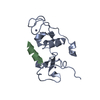 4lk9C 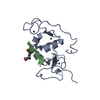 4lkaC C: citing same article ( S: Starting model for refinement |
|---|---|
| Similar structure data |
- Links
Links
- Assembly
Assembly
| Deposited unit | 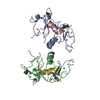
| ||||||||
|---|---|---|---|---|---|---|---|---|---|
| 1 | 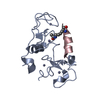
| ||||||||
| 2 | 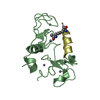
| ||||||||
| Unit cell |
| ||||||||
| Noncrystallographic symmetry (NCS) | NCS domain: (Details: chain D and segid) NCS domain segments: (Selection details: chain 'D' and segid ' ') |
- Components
Components
| #1: Protein | Mass: 15499.267 Da / Num. of mol.: 2 / Fragment: unp residues 194-323 Source method: isolated from a genetically manipulated source Source: (gene. exp.)  Homo sapiens (human) / Gene: KAT6A, MOZ, MYST3, RUNXBP2, ZNF220 / Plasmid: pET15b / Production host: Homo sapiens (human) / Gene: KAT6A, MOZ, MYST3, RUNXBP2, ZNF220 / Plasmid: pET15b / Production host:  #2: Protein/peptide | Mass: 2302.679 Da / Num. of mol.: 2 / Fragment: unp residues 2-22 / Source method: obtained synthetically / Source: (synth.)  Homo sapiens (human) / References: UniProt: P68431 Homo sapiens (human) / References: UniProt: P68431#3: Chemical | ChemComp-ZN / #4: Water | ChemComp-HOH / | Has protein modification | Y | |
|---|
-Experimental details
-Experiment
| Experiment | Method:  X-RAY DIFFRACTION / Number of used crystals: 1 X-RAY DIFFRACTION / Number of used crystals: 1 |
|---|
- Sample preparation
Sample preparation
| Crystal | Density Matthews: 2.34 Å3/Da / Density % sol: 47.38 % |
|---|---|
| Crystal grow | Temperature: 283 K / Method: vapor diffusion / pH: 8.5 Details: 100 mM Tris-Cl, 200 mM Li2SO4, 30% PEG 4000, pH 8.5, VAPOR DIFFUSION, temperature 283K |
-Data collection
| Diffraction | Mean temperature: 100 K | ||||||||||||||||||||||||||||||||||||||||||||||||||||||||||||||||||||||||||||||||||||||||
|---|---|---|---|---|---|---|---|---|---|---|---|---|---|---|---|---|---|---|---|---|---|---|---|---|---|---|---|---|---|---|---|---|---|---|---|---|---|---|---|---|---|---|---|---|---|---|---|---|---|---|---|---|---|---|---|---|---|---|---|---|---|---|---|---|---|---|---|---|---|---|---|---|---|---|---|---|---|---|---|---|---|---|---|---|---|---|---|---|---|
| Diffraction source | Source:  SYNCHROTRON / Site: SYNCHROTRON / Site:  Diamond Diamond  / Beamline: I04-1 / Wavelength: 0.91732 Å / Beamline: I04-1 / Wavelength: 0.91732 Å | ||||||||||||||||||||||||||||||||||||||||||||||||||||||||||||||||||||||||||||||||||||||||
| Detector | Type: DECTRIS PILATUS 2M / Detector: PIXEL / Date: Feb 3, 2012 | ||||||||||||||||||||||||||||||||||||||||||||||||||||||||||||||||||||||||||||||||||||||||
| Radiation | Protocol: SINGLE WAVELENGTH / Monochromatic (M) / Laue (L): M / Scattering type: x-ray | ||||||||||||||||||||||||||||||||||||||||||||||||||||||||||||||||||||||||||||||||||||||||
| Radiation wavelength | Wavelength: 0.91732 Å / Relative weight: 1 | ||||||||||||||||||||||||||||||||||||||||||||||||||||||||||||||||||||||||||||||||||||||||
| Reflection | Resolution: 2.5→29.1 Å / Num. all: 11753 / Num. obs: 11753 / % possible obs: 99.6 % / Redundancy: 9.5 % / Biso Wilson estimate: 27.97 Å2 / Rsym value: 0.157 / Net I/σ(I): 12.4 | ||||||||||||||||||||||||||||||||||||||||||||||||||||||||||||||||||||||||||||||||||||||||
| Reflection shell | Diffraction-ID: 1
|
- Processing
Processing
| Software |
| ||||||||||||||||||||||||||||||||||||||||||
|---|---|---|---|---|---|---|---|---|---|---|---|---|---|---|---|---|---|---|---|---|---|---|---|---|---|---|---|---|---|---|---|---|---|---|---|---|---|---|---|---|---|---|---|
| Refinement | Method to determine structure:  MOLECULAR REPLACEMENT MOLECULAR REPLACEMENTStarting model: pdb entry 4LJN Resolution: 2.5→29.1 Å / Occupancy max: 1 / Occupancy min: 1 / FOM work R set: 0.8127 / SU ML: 0.3 / σ(F): 0 / Phase error: 25.36 / Stereochemistry target values: ML
| ||||||||||||||||||||||||||||||||||||||||||
| Solvent computation | Shrinkage radii: 0.7 Å / VDW probe radii: 0.9 Å / Solvent model: FLAT BULK SOLVENT MODEL | ||||||||||||||||||||||||||||||||||||||||||
| Displacement parameters | Biso max: 76.32 Å2 / Biso mean: 34.8729 Å2 / Biso min: 10.65 Å2 | ||||||||||||||||||||||||||||||||||||||||||
| Refinement step | Cycle: LAST / Resolution: 2.5→29.1 Å
| ||||||||||||||||||||||||||||||||||||||||||
| Refine LS restraints |
| ||||||||||||||||||||||||||||||||||||||||||
| Refine LS restraints NCS | Number: 102 / Type: POSITIONAL / Rms dev position: 0.131 Å | ||||||||||||||||||||||||||||||||||||||||||
| LS refinement shell | Refine-ID: X-RAY DIFFRACTION / Total num. of bins used: 5
|
 Movie
Movie Controller
Controller


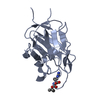
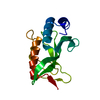
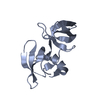
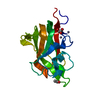
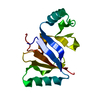


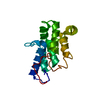

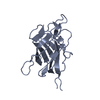
 PDBj
PDBj

















